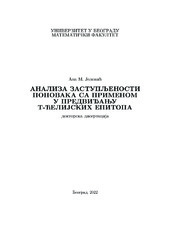Приказ основних података о дисертацији
Анализа заступљености поновака са применом у предвиђању т-ћелијских епитопа
Analysis of repeat representation with application in predicting T-cell epitopes
| dc.contributor.advisor | Mitić, Nenad | |
| dc.contributor.other | Malkov, Saša | |
| dc.contributor.other | Kovačević, Jovana | |
| dc.contributor.other | Ognjanović, Zoran | |
| dc.creator | Jelović, Ana | |
| dc.date.accessioned | 2023-11-28T17:18:31Z | |
| dc.date.available | 2023-11-28T17:18:31Z | |
| dc.date.issued | 2023-09-30 | |
| dc.identifier.uri | https://eteze.bg.ac.rs/application/showtheses?thesesId=9378 | |
| dc.identifier.uri | https://fedorabg.bg.ac.rs/fedora/get/o:31838/bdef:Content/download | |
| dc.identifier.uri | https://plus.cobiss.net/cobiss/sr/sr/bib/130996489 | |
| dc.identifier.uri | https://nardus.mpn.gov.rs/handle/123456789/21891 | |
| dc.description.abstract | Први део овог рада се бави дефинисањем различитих типова поновака, као и поновака коjи задовољаваjу маске мотива. Развиjен jе метод за њихово прецизно проналажење у улазним секвенцама коjе могу бити веома дугачке. Како броj нађених резултата може бити веома велики, метод укључуjе и њихово филтрирање на основу очекиваног броjа поjављивања. Метод jе прво примењен на протеинским секвенцама у коjима су експериментално потврђени Т-ћелиjски епитопи регистровани у бази података IEDB. Над нађеним поновцима примењена су правила придруживања у циљу конструисања модела коjи би омогућио предвиђање позициjа Т-ћелиjских епитопа у протеинским секвенцама. На оваj начин би се истраживачима наговестио регион у протеинскоj секвенци где се са великом поузданошћу може очекивати епитоп. У случаjу Т-ћелиjских епитопа нађен jе велики броj правила са високом поузданошћу коjи се могу сматрати поузданим индикаторима позициjе T-ћелиjских епитопа унутар протеинске секвенце. На основу нађених резултата формирана су и правила придруживања коjа детаљниjе карактеришу епитопе и са њима повезане поновке. Како jе нађен велики броj резултата само њихов део jе представљен у раду. На основу ниски коjима су одређени поновци са задовољаваjућом поузданошћу тражене су и маске мотива коjе jе потребно да поновци задовољаваjу како би процес њиховог тражења био што jедноставниjи. Цео поступак jе примењен како код директних некомплементарних поновака тако и код индиректних некомплементарних поновака. Са сличним резултатима jе цео поступак урађен и код Б-ћелиjских епитопа над подацима из базе података IEDB. Подаци о експериментално потврђеним кратким линеарним мотивима су преузети из базе података ELM и у протеинским секвенцама где су кратки линеарни мотиви регистровани тражени су поновци. Над њима су примењена правила придруживања. Посебно су издвоjена правила са високом поузданошћу. На основу нађених резултата тражене су маске мотива коjе нађени поновци задовољаваjу. | sr |
| dc.description.abstract | In the first part of this dissertation different repeat types are defined as well as repeats that satisfy motif masks. A method for precise repeat finding in input sequences of arbitrary length has been described. As the input sequences can be very long, the number of found repeats can also be large. For that reason it is important that the method also includes filtering found repeats based on the expected number of their occurrences. The method was first applied to protein sequences in which experimentally confirmed T-cell epitopes from the IEDB database were registered. Association rules were applied to the found repeats in order to construct a model that would enable the prediction of the positions of T-cell epitopes in protein sequences. In this way, it would indicate to researchers a region in the protein sequence where an epitope can be expected with high confidence. In the case of T-cell epitopes, a large number of rules with high confidence was found. These rules can be considered as reliable predictors of the position of T-cell epitopes within the protein sequences. Based on the results found, association rules were formed that characterize the epitopes and the repeats associated with them in more detail. As a large number of results were found, only their part is presented in this dissertation. On the basis of the strings that determine the repeat, a motif mask that the repeat needs to satisfy was searched for. The entire procedure was applied to both direct non-complementary repeats and indirect non-complementary repeats. With similar results, the entire procedure was applied to B-cell epitopes on data from the IEDB database. Data on experimentally confirmed short linear motifs were taken from the ELM database. In protein sequences where short linear motifs were registered, repeats were searched for and association rules were applied to them. The rules with high confidence have been singled out in particular. On the basis of the results found, motif masks that repeats with high confidence would satisfy were searched for. | en |
| dc.format | application/pdf | |
| dc.language | sr | |
| dc.publisher | Универзитет у Београду, Математички факултет | sr |
| dc.rights | openAccess | en |
| dc.source | Универзитет у Београду | sr |
| dc.subject | поновци, Т-ћелиjски епитопи, кратки линеарни мотиви, правила придруживања | sr |
| dc.subject | repeats, T-cell epitopes, short linear motifs, association rules | en |
| dc.title | Анализа заступљености поновака са применом у предвиђању т-ћелијских епитопа | sr |
| dc.title.alternative | Analysis of repeat representation with application in predicting T-cell epitopes | en |
| dc.type | doctoralThesis | |
| dc.rights.license | ARR | |
| dc.identifier.fulltext | http://nardus.mpn.gov.rs/bitstream/id/157145/Disertacija_14459.pdf | |
| dc.identifier.fulltext | http://nardus.mpn.gov.rs/bitstream/id/157146/Izvestaj_Komisije_14459.pdf | |
| dc.identifier.rcub | https://hdl.handle.net/21.15107/rcub_nardus_21891 |



